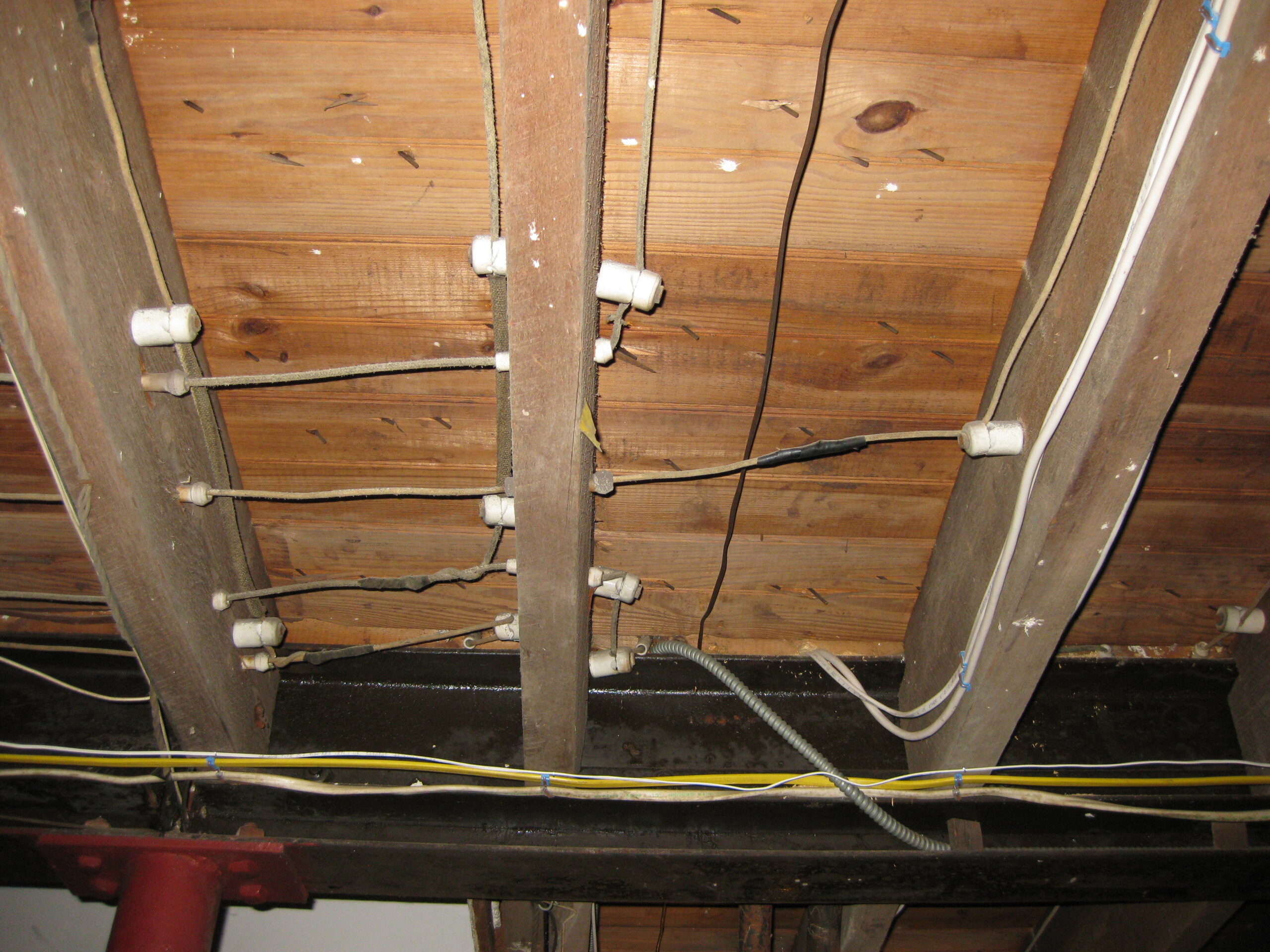When electricity was first made available in residential and commercial buildings during the late 19th century, it was connected through a wiring system called “knob and tube” wiring. Up until the late 1940s and early 50s, knob and tube wiring was innovative bringing Edison’s light bulbs to homes around the country. But nowadays it’s outmoded and deteriorating …with the potential to be a hazard. Knob & tube wiring should be replaced whenever possible.
So what is exactly is knob-and-tube wiring?

The wiring system gets its name from the ceramic knobs that support it and the ceramic tubes that helped insulate and protect
the wires as they pass through wood framing members such as floor joists, wall studs or ceiling beams. Splices were usually made by soldering the wires together and then just wrapped up with cloth tape, left exposed without the splice being contained in an electrical box (a requirement today). The wires were protected with a cotton cloth covering saturated with asphalt, called “loom”.
Click on Video Link
What can be done?
While knob-and-tube wiring is older, it is not necessary to replace it simply because you have it in your house. But it is important to be aware of concerns such as short-circuiting and overheating. Having it inspected and evaluated annually, is important.
The best time to replace knob and tube wiring in your house is when you are remodeling your home. This is less expensive, as walls, ceilings, and floors are usually open and accessible. Many homeowners replace knob-and-tube as individual rooms are remodeled. Remodeling projects usually include adding more receptacles, ground-fault and arc-fault circuit interrupters.
Home Insulation:
The National Electrical Code prohibits the use of insulation of any sort installed in walls or ceilings where knob and tube wiring exists. This is because of a potential fire hazard. If any sort of insulation comes into contact with the conductors, they can’t disperse heat properly.
Common problems with knob-and-tube wiring:
- Poor Connections: Problems with knob-and-tube wire almost always result from amateurish connections made after original installation.
- Damage: Knob-and-tube wiring is invariably old and may have been subjected to wear and tear over the years.
- Brittleness: As mentioned earlier, the rubber insulation on knob-and-tube can become brittle caused in high heat areas, including connections above ceiling light fixtures.
- Circuits Extended: Since older electrical systems had few circuits by today’s standards, the chances of each knob-and-tube circuit having been extended over the years, is very good. This increases the possibility of poor connection, damage and brittleness.
Differences between modern wiring and knob-and-tube:
- With knob and tube, there are only two wires. The black and white wires are run separately and are spaced several inches apart, allowing for ventilation and for the heat to disperse. In modern wiring, the black wire, white wire and ground wire are all wrapped up in a single cable.

- In many instances with knob and tube, the “neutral” wire had been switched with the “hot” wire. This dangerous practice violates modern electrical code, but was a common practice in the knob and tube era.
- Knob-and-tube wiring is insulated with rubber. Modern wiring is insulated with plastic. The cloth-like or rubber insulation used on knob-and-tube wiring, deteriorates and may cause the conductor to be bare and unprotected – a real shocker (so to speak), or in some cases – a real fire!
- With knob and tube, there is no equipment-grounding conductor, such as a ground wire. A ground wire, sometimes
 also referred to as a “grounded” wire, is an electrical wire that neutralizes and protects devices, appliances, and buildings from electrical current problems and shocks. Grounding is arguably the most important part of a sound electrical system. One telltale sign that an electrical outlet might be fed with knob and tube is that the receptacle is only a “2-prong” version, missing the 3rd prong on the bottom, which is for the grounding conductor.
also referred to as a “grounded” wire, is an electrical wire that neutralizes and protects devices, appliances, and buildings from electrical current problems and shocks. Grounding is arguably the most important part of a sound electrical system. One telltale sign that an electrical outlet might be fed with knob and tube is that the receptacle is only a “2-prong” version, missing the 3rd prong on the bottom, which is for the grounding conductor.
One last important consideration:
Knob & Tube wiring served its purpose back in the day when it was used to power things such as electric lamps and table fans – not modern equipment such as air conditioners, refrigerators, computers, space heaters, etc. With today’s modern appliances and conveniences drawing much greater loads than knob and tube was ever designed to handle, homeowners are rolling the dice in not dealing with the situation.
As a result of the possible hazards posed by this antiquated wiring system, most insurance companies will not insure your home if it contains knob and tube wiring, or a fuse panel, for that matter.
McCurdy Electric
We, at McCurdy Electric, are always available to inspect and consult with you regarding safety issues, concerns and your options. Our expert team can quickly diagnose, and if necessary, upgrade the old wiring system to current safe code standards.
Having had many years of experience working in older New England homes, we know how to quickly and safely remove and replace knob and tube wiring at a very competitive cost.
I’m John McCurdy, president of McCurdy Electric. For any questions regarding knob and tube wiring or any other electrical issues, please call me at 781-595-7074 and I will personally answer any questions or concerns you may have.


0 Comments